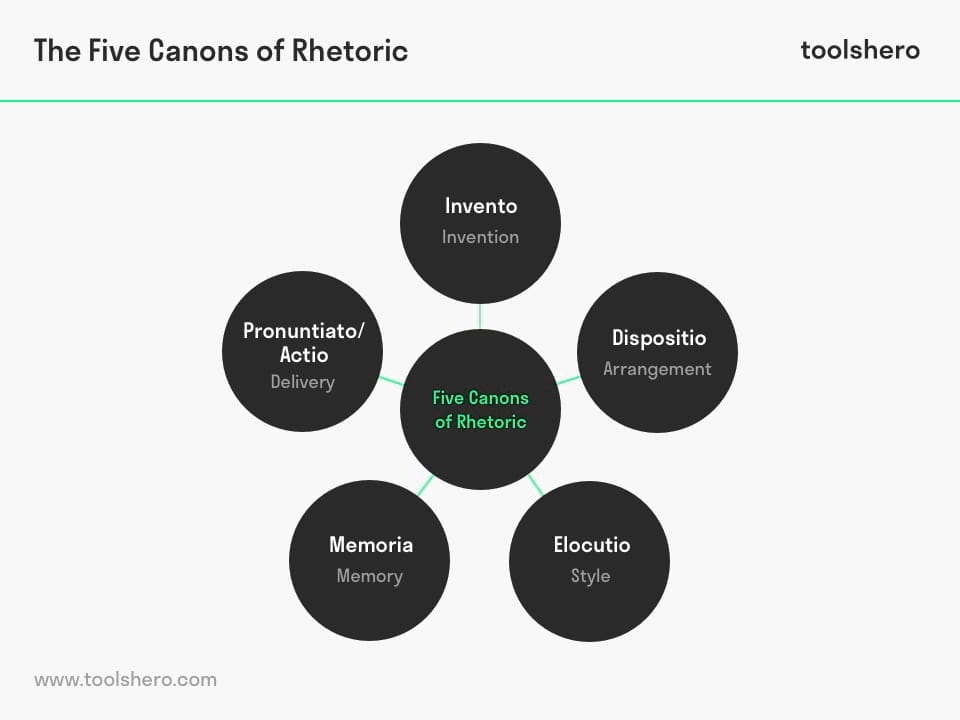Five Canons of Rhetoric (Aristotle)

Five Canons of Rhetoric: this article explains the Five Canons of Rhetoric in a practical way. Next to what this theory is, this article also highlights these five canons, the role of persuasiveness and the improtance of timing. After reading it, you will understand the basics of this useful communication skills tool. Enjoy reading!
What are the Five Canons of Rhetoric? The theory
Greek sage and philosopher Aristotle first described rhetoric as a way to develop and prepare public speeches. Today, the Five Canons of Rhetoric are mostly used for creative thinking and clear communication.
The classical rhetoric of the 5 cannons originated 50 years before Christ and was written by Roman orator and writer Cicero, and laid down in 4 volumes. Approximately 200 years later, these 5 cannons were described in a small manual on rhetoric by Roman rhetorician Quintilian.
This manual was called ‘Institutio Oratoria’; Institutes of Oratory. The book became the basis for rhetorical education.
The 5 cannons of rhetoric are still a useful guide for creating powerful speeches and/or writing clear explanations. The Five Canons of Rhetoric help in the process of developing an effective message.
The Five Canons of Rhetoric
The purpose of rhetoric is to use arguments well and accurately. This can convince an audience of a specific stance. The five categories, which are also called cannons, help in doing this as powerfully and naturally as possible. They offer a template for rhetorical discourse:

Figure 1 – Five Canons of Rhetoric model (Aristotle)
1. Invento = Inventio
This category concerns inventing a good idea and considering what the audience will find useful in advance. What does the audience want to hear and why? In this phase, it’s useful to fully describe the audience (target group) using definitions and classifications. By considering the topics that need to be discussed in advance, a structure is formed.
According to Aristotle, this is about finding the available methods for convincing the audience. It’s also the most difficult phase in writing a speech, as this is the foundation for all other phases. You need to build something from nothing. Something that serves as the framework for the entire discourse.
The purpose of this phase is to brainstorm on what will be said. It’s the process of development and refinement of all arguments. Moreover, the preparation of the way in which the message is shared takes place here.
Persuasiveness plays an important role as well. Without guidance, brainstorming doesn’t lead to good results. By considering the next categories, the effectiveness of this phase will only increase.
2. Dispositio = arrangement
The foundation for the structure of the discourse already took place based on the topics that were collected in phase 1. The composition and refinement of the structure is now developed further in combination with the cohesive arguments.
After all, it is important that the arguments have the maximum impact on the audience and that the audience is convinced. By organising a speech well, a clear structure is created in the story. A choice can be made to repeat the initial subject, question or statement at the end.
By placing the most important message at the beginning, this will have a convincing effect on the audience. For this reason, it’s a good idea to consider where words, statements, paragraphs etc.are placed.
Today, the beginning-middle-end rule applies, in which the introduction (beginning) establishes what will be said. To create interaction with the audience, it’s possible to open with a question or statement that’s confirmed or disproved during the story with the use of arguments (middle).
It’s also possible to start with a problem definition and provide proof and facts later in the story to confirm this. At the end, a conclusion takes place and a short summary of the rhetoric (end). It’s important to make a strategic decision on what is said last, and where the most important points of attention are.
3. Elocutio = style
This category reflects the fun, artistic aspect of communication. It’s aimed at the style of communication; does the story contain humour, is it interesting, exciting, cynical or purely informative? Which words are chosen and what decisions are made to influence the audience? What is the talking pace, do you apply tropes, metaphors or other linguistic tools to involve the listener in the story? Is the speaker able to trigger emotions in the audience during the presentation?
4. Memoria = memory
This category is mainly about memory; is the speaker able to remember the speech word by word? Is the speaker able to use famous quotes, literary references and other facts and use them during improvised speeches? These days, the preparation of a speech is of great importance, so it becomes easier to remember and reproduce the t ext naturally.
Reading a speech has a less powerful effect. It’s aimed at the process of learning and remembering, so there’s no need for notes or other records during the speech. The goal is to communicate powerfully and without hesitation.
The speaker needs to know as much as possible from the subject, this also makes him capable of improvising and quickly answering questions from the audience. This way, he shows he’s familiar with the subject-matter and comes across professionally.
5. Pronuntiato / Actio = delivery
In this last category of the Five Canons of Rhetoric, it’s about the effective use of non-verbal communication, including gestures, facial expressions, posture and intonation of the voice.
The entire delivery determines whether the audience is at the edge of their seats or reclined with their arms crossed and yawning.
The power of non-verbal communication can only grow through continuous practice and controlling the own gestures, pronunciation, pitch, stress and speed. The speaker is the one who’s capable of convincing their audience and maybe even persuading them to do something. Eye contact, the way someone dresses and the confident and professional posture of the speaker are also an important aspect in this category.
Persuasiveness and the Five Canons of Rhetoric
Long before Christ, Aristotle already wrote about the three tools of persuasion, which also apply to the five cannons of rhetoric; pathos, logos and ethos. Pathos is about using and playing the audience’s emotions.
The success of the attempt of persuasion depends on the emotional state of the audience, as well as the delivery and style of the speech. Logos calls to logical reasoning, the ability of the human mind to understand things, and the knowledge people posses about the world and each other.
Ethos is when the speaker draws on their own authority and personality in order to convince the audience he is a qualified speaker. The more professional the speaker and the more knowledge he has on the subject, the more powerful the ethos.
Ideally a beautiful mix of all pathos, logos and ethos is recommended for a speech; the target audience does, however, have an influential role. An audience consisting of mainly scientist will be easier to convince when the focus lies on logos, for example.
If the speech has a funnier character, pathos can take a more dominant place. If the audience is somewhat suspicious and prefers to wait-and-see, then pathos will help in convincing the listeners.
Five Canons of Rhetoric: the importance of Timing
One of the most important factors in preparing a convincing speech is to adjust the message to a specific audience.
Information about their interests, needs and knowledge will help in collecting the right information and implementing this in arguments. Proof, in any form, can also help here. Think of information from research, jurisdiction, statistics and individual testimony, for example.
Depending on the context, the audience is open to certain ideas at specific moments.
Timing in the story plays a large role here. This means that the emphasis falls on certain words, pauses are taken to breathe at the right moments and the speaker waits while the audience is laughing or applauding before continuing to talk. In persuasion, the audience’s attention is invaluable.
It’s Your Turn
What do you think? Have you ever heard of the Five Canons of Rhetoric? Do you recognize the practical explanation or do you have more suggestions? What are your success factors for verbal, non-verbal and written communication?
Share your experience and knowledge in the comments box below.
More information
- Leach, J. (2000). Rhetorical analysis. Qualitative researching with text, image and sound, 207-226.
- McCroskey, J. C. (2015). An introduction to rhetorical communication. Routledge.
- Prior, P., Solberg, J., Berry, P., Bellwoar, H., Chewning, B., Lunsford, K. J., & Van Ittersum, D. (2007). Re-situating and re-mediating the canons: A cultural-historical remapping of rhetorical activity. Kairos, 11(3), 1-29.
How to cite this article:
Mulder, P. (2018). Five Canons of Rhetoric (Aristotle). Retrieved [insert date] from Toolshero: https://www.toolshero.com/communication-methods/five-canons-of-rhetoric/
Original publication date: 01/30/2018 | Last update: 11/16/2023
Add a link to this page on your website:
<a href=”https://www.toolshero.com/communication-methods/five-canons-of-rhetoric/”>Toolshero: Five Canons of Rhetoric (Aristotle)</a>












